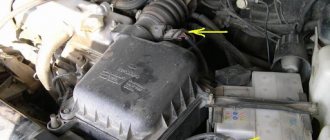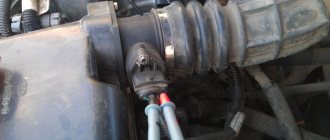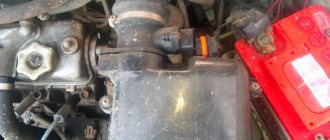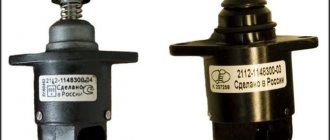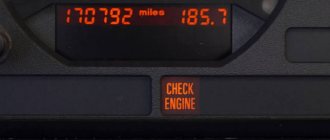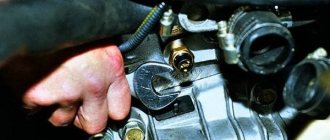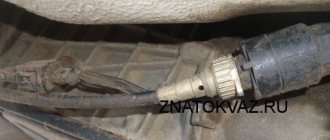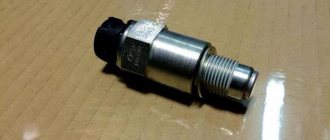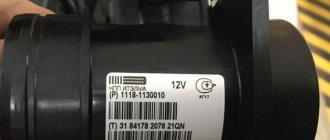The Nine managed to make a lot of noise among the people, in the 90s “bandits” drove it, and in the 2000s it was used by young people, but even today there are more than enough of these cars. Initially, in 1993, the VAZ 2109 was equipped with a carburetor engine, but progress did not stand still and in the late 90s the nine received an injection engine, which had a positive effect on its technical characteristics.
As you know, for proper and reliable operation, an injection engine requires a large number of sensors and a “brain” that will manage it all. There are a lot of sensors on the VAZ 2109 and they are all interconnected in their own way.
This article will focus specifically on the sensors of the injector system on the VAZ 2109, namely, their purpose, location and signs of malfunction.
Electronic engine control unit
The engine control unit is responsible for the operation of almost the entire car. In this part, hundreds of processes are calculated, all readings from sensors installed on the car are processed. Many people call the ECU a “computer” and it’s impossible to disagree with this. The unit, receiving readings from the sensors, processes them and controls the engine, adjusting the supply of fuel and air to the combustion chamber.
Location
The engine control unit on the VAZ 2109 is located under the glove compartment at the feet of the front passenger. You can see it by looking under the panel; the block is closed with a special plastic cover.
Signs of malfunction:
Problems with the operation of the sensor are most often associated with damage to the microcircuit, for example, burnout of a track or damage to one of the radio components, due to which one of the cylinders may fail, etc. It is quite difficult to judge the failure of the ECU based on its symptoms, since they are all similar to the failure of one of the sensors, so the malfunction of the unit can only be determined by diagnosing, disassembling, or replacing it with a known good one.
Diagnosis of device malfunctions
Determining a problem with the mass air flow sensor is not so easy. Many symptoms of failure of this sensor coincide with signs of failure of other components and assemblies of the car. Typical symptoms of problems with the mass air flow sensor are cases when:
- the engine noticeably loses power;
- there are failures when pressing the accelerator;
- fuel consumption increases significantly;
- Starting a warm engine becomes more difficult.
When the mass air flow sensor fails, the Check Engine light on the dashboard lights up. But it turns on not only when the mass air flow sensor fails. And it’s not at all easy to figure out what kind of breakdown the indicator is signaling in this case, so it’s better to turn to professionals for diagnostics.
Cases when the average car enthusiast can figure it out on his own are relatively rare. These include a situation when you suspect a failure of the mass air flow sensor, and your friend has the same “nine” as yours with a perfectly working engine. Borrow a known-good air flow sensor from a friend for one hour. Remove your sensor, install a good one, and go for a ride. If the problems disappear, go to the store for a flow meter: the problem is that the mass air flow sensor is broken.
For some BOSH sensors, craftsmen offer a method of instrumental performance monitoring. The approach is applicable to flow meters with catalog indexes 0-280-218-004, 0-280-218-037, 0-280-218-116. A portable DC voltmeter up to 2 Volts is used for testing. Measure the voltage between the first (yellow wire) and third (green wire) pins of the mass flow sensor. Take measurements with the ignition on, but do not start the engine. A voltage of 1.02 V or less indicates that the sensor is working, and a voltage of 1.05 V or more indicates that it is broken.
Pay attention to the accuracy class of the device; differences of 1–2 units in the rightmost digit often lie within the error range.
Speed sensor
With the transition of the nine to an injector, the measurement of vehicle speed began to be carried out not mechanically, using a special sensor that reads readings from the rotation of the gearbox gears, transmitting the readings to the computer. The block processes the readings from the sensor and sends signals to the speedometer.
Location
The VAZ 2109 speed sensor is located on the gearbox housing, you can see it by looking under the thermostat and you can find this sensor next to the gearbox dipstick.
Signs of malfunction:
- The speedometer does not work;
- The speedometer does not show the speed correctly;
- The odometer does not work;
Knock sensor
The knock sensor on the nine is used to detect detonations in the engine that occur due to low-quality fuel. These detonations can cause serious damage to the engine if they are not corrected in time, which is exactly what the knock sensor does. It detects detonation, then sends a signal to the ECU, which adjusts the ignition timing, thereby reducing detonation in the engine.
Location
The knock sensor is located on the block in the middle, it can be seen between the 2nd and 3rd cylinders.
Signs of malfunction:
- Fingers knocking;
- Loss of vehicle dynamics;
- High fuel consumption;
When should you clean the sensor?
The condition and degree of wear of the air filter on which the first one is installed is of great importance for the long and proper operation of the sensor. So, if the filter is in good working order and does a good job of filtering dust particles and small abrasive particles in the air, then the sensor will last a long time. If the filter wears out, the sensor quickly becomes dirty and stops working correctly.
You can find out that the VAZ 2114 DMRV needs to be cleaned by one of the following signs:
- the car is poorly controlled when accelerating, there are sharp drops in speed, acceleration and jerking;
- engine speed at idle is extremely high or, on the contrary, intermittent;
- fuel consumption has increased sharply (in the case of the 14th model it can increase even by 50%);
- the engine stopped starting.
Cleaning the air flow sensor using mechanical force or a jet of compressed air is strictly prohibited - such a procedure will instantly lead to its breakdown.
In most of these cases, it is not necessary to immediately run for a new sensor - simply cleaning it will help.
Air flow sensor
The mass air flow sensor, also known as MAF, is probably the most famous and most recognizable sensor of all the sensors in a car. Its purpose is to count the air entering the engine. Air counting is necessary to create the air-fuel mixture in the correct proportions.
Location
The VAZ 2109 air flow sensor is located on the intake corrugation between the throttle valve and the air filter housing.
Signs of malfunction:
- Idle speed fluctuates;
- The car does not pull well;
- The engine stalls spontaneously;
Mass air flow sensor (MAF) for VAZ 21083, 21093, 21099 cars
The mass air flow sensor (MAF, air flow meter) is an element of the vehicle's electronic engine control system (ECM). Here are the basic information about this sensor.
Purpose of the mass air flow sensor
The mass air flow sensor is designed to determine the amount of air entering the cylinders of a car engine over a certain period of time (kg/h).
Mass air flow sensor design
The mass air flow sensor installed on VAZ 21083, 21093, 21099 vehicles has a sensitive element (sensors manufactured by GM and BOSCH have different designs). For GM air mass flow sensors, these are three sensitive elements installed in the intake air flow: one determines the air temperature, the other two heat up to a temperature slightly higher than the ambient air temperature. The BOSCH MAF has a sensitive element - a thin mesh (membrane). The grid contains a heating resistor and two temperature sensors.
Location on a VAZ 21083, 21093, 21099 car
The air flow sensor on VAZ 21083, 21093, 21099 vehicles is installed between the air filter and the throttle pipe.
Operating principle of the mass air flow sensor
When the engine is running, the air passing through the mass air flow sensor cools the sensing element heated to a certain value. The system requires some increase in power to maintain the sensing element within the specified temperature limits. The controller (control unit, ECU) measures this electrical power and, based on the magnitude of its change, calculates the amount of air entering the engine cylinders (air mass in a certain period of time). Further, in accordance with this indicator, as well as readings from the crankshaft position sensor (current engine speed), it calculates the amount of injected fuel necessary to create an optimal fuel-air mixture at different engine operating modes (changes the duration of opening of the injectors) and sets required ignition timing.
The signal from the mass air flow sensor is a direct current voltage varying in the range from 4 to 6 V for a GM air flow sensor, 1 - 5 V for a BOSCH mass air flow sensor. The BOSCH mass air flow sensor has a temperature sensor, the readings of which the controller also takes into account when determining the injection amount.
DMRV malfunctions
Signs of a faulty air flow sensor are problems with starting a warm engine (the engine starts and stalls), “dips” and “jerks” when pressing the gas pedal, loss of power and engine response, increased fuel consumption, unstable idle. The sensor itself may fail (possibly due to contamination and oiling of the sensitive elements) or the wires leading to it, which must be taken into account when identifying a malfunction. In addition, the “suction” of unaccounted air into the intake tract after the sensor can lead to similar problems in engine operation (since the fuel mixture becomes leaner).
If the mass air flow sensor fails, the controller switches the engine control system to backup mode. In this case, the “Check Engine” light on the instrument panel lights up, and a fault code is recorded in RAM. The idle speed control is set in 120 steps (increased idle speed). When calculating the fuel supply in such a situation, the controller uses readings from the throttle position sensor and the calculated engine speed. Fuel consumption in standby mode increases.
In some cases, the performance of the mass air flow sensor can be restored by cleaning it with a liquid for cleaning carburetors (relevant for engines with high mileage, worn-out CPG, clogged crankcase ventilation system) with the concomitant replacement of the engine air filter.
Applicability of mass air flow sensor on VAZ 21083, 21093, 21099 vehicles
On injection engines of VAZ 2108, 2109, 21099 cars, two types of mass air flow sensors are used: GM and BOSСH. They are not interchangeable.
Mass air flow sensor GM: 2112-1130010, 2112-1130010-01 (controllers January 4.1, GM ISFI-2S (2111-1411020-10 (20, 21)).
MAF BOSCH:
21083-1130010-01 (BOSСH M1.5.4 controller);
21083-1130010-10 (controllers BOSCH M1.5.4, MP7.0H, M1.5.4N, M7.0H, VS5.1, January 5.1, 5.1.1, 5.1.2).
Notes and additions
— In some cases, if the mass air flow sensor fails and the engine does not want to start, you can remove the chip with wires from the sensor and start the engine with the mass air flow sensor disconnected. The ECM will switch to standby mode and the engine will start running. The idle speed in standby mode will be kept within 2000 rpm.
Twokarburators VK - More information on the topic in our VKontakte group, on Facebook Twokarburators FS and on Odnoklassniki - Twokarburators OK
More articles on the VAZ injector
— Idle speed regulator for injection VAZ 21083, 21093, 21099
— Applicability of ECU controllers for injection engines of VAZ 21083, 21093, 21099 cars
— Coolant temperature sensor for injection VAZ 21083, 21093, 21099
— Crankshaft position sensor for injection engines of VAZ 21083, 21093, 21099 cars
— Diagram of the power supply system for injection VAZ 21083, 21093, 21099
Throttle position sensor
This sensor is necessary to determine the opening angle of the throttle valve. These readings are necessary to correctly determine the air supply to the engine. TPS works in tandem with IAC and mass air flow sensor. Since the sensor is made of a rheostatic type, that is, it changes its resistance with each opening of the throttle, it quite often fails.
Location
The TPS is located on the throttle valve of the VAZ 2109.
Signs of malfunction:
- The speed ranges from 500 to 2500 rpm;
- The engine starts poorly;
- No idle;
Idle speed control
The idle speed sensor is a DC motor with a “cap” on its shaft that acts as a valve. This valve closes the channel in the throttle valve, thereby opening or closing the air supply to idle. The IAC only works at idle and at high speeds, when the throttle valve is open, it does not participate.
Location
The VAZ 2109 idle speed regulator is located on the throttle valve on the reverse side.
Signs of malfunction:
- Idle speed fluctuates;
- The engine stalls at idle;
Tuning VAZ 2109
The mass air flow sensor, or MAF for short, is perhaps the most expensive of all the sensors in the VAZ 2109 injection system, and other front-wheel drive VAZs. At the time of writing this article, the cost of the sensor is about 2000 rubles. But if your car shows signs of a malfunction of the mass air flow sensor, do not rush to the store for a new sensor, there is a chance to restore its functionality. How to do it yourself will be described in this article. Also, if there are problems with engine traction, simply put, the car “doesn’t move,” then together with cleaning the mass air flow sensor, it makes sense to wash the throttle assembly as well, since our gasoline usually clogs everything there with deposits.
I would like to immediately warn you: if the sensor fails, that is, there is damage to the sensor parts, then it will not be possible to restore it. It is possible to revive only a mass air flow sensor that is not working properly due to contamination of its critical components.
To work, we will need carburetor cleaning fluid and wrenches for star bolts.
We unscrew the clamp and two “10” bolts and remove the pipe in which the mass air flow sensor itself is located.
To remove the sensor itself, sprocket keys are useful.
Carburetor fluid should be sprayed here:
We act very carefully so as not to damage these parts and let the liquid evaporate.
While we dry the sensor, we remove the throttle assembly itself. To do this, you need to disconnect the electrical connectors from the throttle position sensor and the idle speed control, disconnect all the pipes (4 pieces) and unscrew a couple of nuts.
This is what is inside the throttle assembly - all the channels and the valve have a black coating.
We must remove it using the same liquid from the can.
You don’t have to disconnect the throttle cable, just place the assembly on a rag and treat the contaminated areas with liquid. Just be careful, this liquid is very caustic and contact with the skin and eyes is highly undesirable!
Also, don’t forget to remove the idle air control (attached to the throttle body with two screws) and wash the space under it, there is usually no less dirt there.
This is what you should end up with:
After such cleaning, the car is usually unrecognizable: it starts better, pulls well even when cold, it feels like the engine power has increased.
Such cleaning can and should even be done without waiting for the symptoms described above, but as a preventive measure, especially since it is not at all difficult, and it will not take much time!
(1 vote, average: 5 out of 5)
Share with your friends!
The first turbocharged engine appeared on the Lada. Ford Focus will receive a new EcoBoost engine.
Crankshaft position sensor
The crankshaft sensor (CPS) is one of the main sensors in the car system; if it breaks down, the engine will not even start. It takes readings from the position of the crankshaft, namely, it determines the top dead center of the piston. This is necessary so that the ECU understands when to send a signal to send a spark to the combustion chamber of a certain cylinder.
Location
The DPKV on the VAZ 2109 is located near the generator drive pulley; you can find the sensor by looking behind the oil filter; next to it there is a crankshaft sensor.
Signs of malfunction:
- The engine does not start;
- There is no spark;
- Fills spark plugs;
- Troubles the motor;
Coolant temperature sensor
To measure the coolant temperature in the VAZ 2109, a special sensor is used, which serves to determine the fluid temperature and adjust the fuel mixture. The sensor changes its resistance depending on the temperature of the liquid and transmits the readings to the ECU, and the unit sends signals to the injectors to supply the required amount of fuel to warm up the car.
Location
The DTOZH on the VAZ 2109 is located in the thermostat housing; you can find it by removing the air filter box.
Signs of malfunction:
- The engine does not start well;
- The engine does not start when hot;
- Increased fuel consumption;
Cleaning the sensor yourself
How to clean the air flow sensor at home?
The process is considered using the example of a VAZ 2110 car:
- Turn off the ignition and disconnect the connector from the regulator. It is necessary to dismantle the pipe; to do this, use a wrench to unscrew the bolt or two bolts securing the mass air flow sensor to the air filter housing. The principle of turning off the regulator may vary depending on the car model.
- The regulator must be removed from the hose, otherwise flushing the mass air flow sensor will be ineffective. To dismantle the device from a VAZ car, you will need an asterisk key of the appropriate size. You will need to unscrew the screws, after which you can remove the regulator.
- It happens that there is an oil coating on the device, so it is necessary to make everything as clean as possible. To clean the regulator from deposits, you can use carburetor cleaning fluid. You can also use a special Liqui Moly cleaning agent, it all depends on your financial capabilities. But in fact, there is practically no difference between these liquids. On the film located inside, you can see several sensors made in the form of wire; they are fixed using a special resin. Using carburetor cleaner or any other product, carefully spray this sensitive component. Do this carefully so as not to damage the film. Wait a few minutes until the liquid dries and evaporates. Depending on the amount of contamination, the procedure can be repeated several times. To make the product evaporate faster, you can use a compressor or pump. It is important to remember that a lot of pressure is not required for purging; the device just needs to be dried.
To clean it, you can use other options, as already mentioned, it could be alcohol. In addition to the regulator, you can clean the hose mesh and its inner surface. Pay attention to the pipe - if its condition is poor, there are cracks and other signs of damage, it is advisable to replace it.
But that is not all. Reassemble the components in reverse order. Experts recommend replacing the filter element after this procedure. Before installing the mass air flow sensor, check the tightness of the sealing rubber. Please note that if the seal does not fit tightly, this may lead to the suction of outside air, which is not cleared of impurities. This can lead to accelerated failure of the mass air flow sensor.
In fact, the cleaning procedure allows you to restore the functionality of eight out of ten regulators. It’s worth trying to wash the sensor, because the cost of the procedure is usually 10-15 times less than buying a new regulator.
Failure of the air flow sensor is a fairly common occurrence. But what can cause this, how to determine that the sensor is clogged, as well as how and how to clean the air sensor on a VAZ 2114 - we will look at it in this article.
